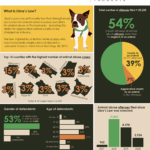When you think of animal cruelty, what comes to mind? Is it the harrowing image of a neglected dog tethered outside with no shelter, or perhaps a cat left behind in a vacant property? While these scenarios evoke immediate emotional reactions, they also lead to a pressing question: is animal cruelty classified as a felony or a misdemeanor? The answer can be quite nuanced and varies significantly from state to state.
Understanding the legal distinctions between felonies and misdemeanors is crucial when discussing animal cruelty laws. A felony generally involves serious crimes that can lead to harsher penalties, including imprisonment for more than one year, heavy fines, or both. In contrast, misdemeanors are less severe offenses, typically punishable by shorter prison sentences, fines, or community service. The classification of these crimes carries implications not just for the perpetrator but also for the animal victims and societal attitudes toward their welfare.
In many jurisdictions, the law addresses animal cruelty in various forms, often categorizing acts into two primary types: intentional acts of violence against animals and neglectful acts that jeopardize their well-being. Intentional cruelty, characterized by willful harm, may often be escalated to felony charges. For example, someone who physically abuses an animal, subjecting it to torture or severe suffering, could potentially be charged with a felony, especially if the abuser has a previous history of similar offenses.
Conversely, neglect, while equally cruel, may be treated as a misdemeanor, particularly in cases where the animal’s basic needs—such as food, water, and proper shelter—are simply not met without malicious intent. It’s an important distinction that raises profound questions about the principles of justice and accountability. Should someone face less severe penalties for neglect that stems from ignorance rather than malice?
Some states have begun to adopt stricter laws against animal cruelty, leading to elevated punishments for both felonies and misdemeanors. A case in point is the implementation of “aggravated cruelty” statutes. Under these laws, particularly heinous acts such as organized dog fighting or inflicting severe injuries can lead to felony charges even in states where most animal cruelty offenses might be labeled as misdemeanors. This illustrates an evolving legal landscape that recognizes the importance of protecting animal rights and represents a growing societal intolerance for cruelty in any form.
The penalties for animal cruelty also vary dramatically between states. For instance, California has made significant strides, as its law categorizes many forms of animal cruelty as felonies, carrying penalties of up to three years of imprisonment and hefty fines. In contrast, some states may only impose a misdemeanor charge, carrying penalties of lower fines and possibly short-term incarceration. Thus, the question remains: Are we, as a society, effectively addressing the issue of animal cruelty, or do our laws need further reevaluation?
Moreover, it is essential to consider the broader implications of these legal classifications. They affect everything from law enforcement to public awareness and advocacy. If animal cruelty is routinely treated as a misdemeanor, it may perpetuate a societal indifference toward animals and discourage individuals from reporting instances of cruelty, believing that the consequences will not lead to substantial change. This legal discrepancy can create an environment that enables perpetrators to repeat their offenses without fear of significant repercussions.
But let’s examine the potential challenges. Moving towards stricter classifications and penalties can often be met with resistance. One argument posits that harsher laws may overwhelm the judicial system and divert resources from addressing more pressing crime. Opponents may assert that some cases of animal cruelty arise from ignorance rather than malice, suggesting that education and rehabilitation might be a more constructive approach than punitive measures. Yet, the line between neglect and intentional harm can be challenging to delineate clearly, presenting a unique dilemma for lawmakers and society alike.
Furthermore, there exists the concept of “the specter of empathy.” How do we cultivate an understanding of sentience in animals, and how does this translate to the legal system? It raises the question of how society values the lives of animals compared to human lives and whether these laws reflect that value accurately. It also challenges communities to consider the broader ethical obligations we have to ensure the welfare of all living beings.
The discourse surrounding animal cruelty laws is not just a legal issue; it is a profoundly moral one. As awareness about the complexities surrounding animal welfare grows, so does the responsibility to reflect this in legislation. We may need to confront uncomfortable truths about our treatment of animals and recognize that the ramifications of these laws extend beyond just the courtroom; they shape societal norms and dictate the kind of behavior that is permissible in our communities.
Ultimately, the legal classification of animal cruelty—whether as a felony or a misdemeanor—serves as a barometer for societal values regarding animal welfare. As our understanding of animals’ emotional and physical capabilities evolves, so too must our laws. It is not merely about right and wrong; it is about striving for a world where compassion triumphs over cruelty and where the innocent are not just protected, but revered. Will we rise to the challenge and push for change, or will we allow the status quo to persist? The answer rests in our hands.









